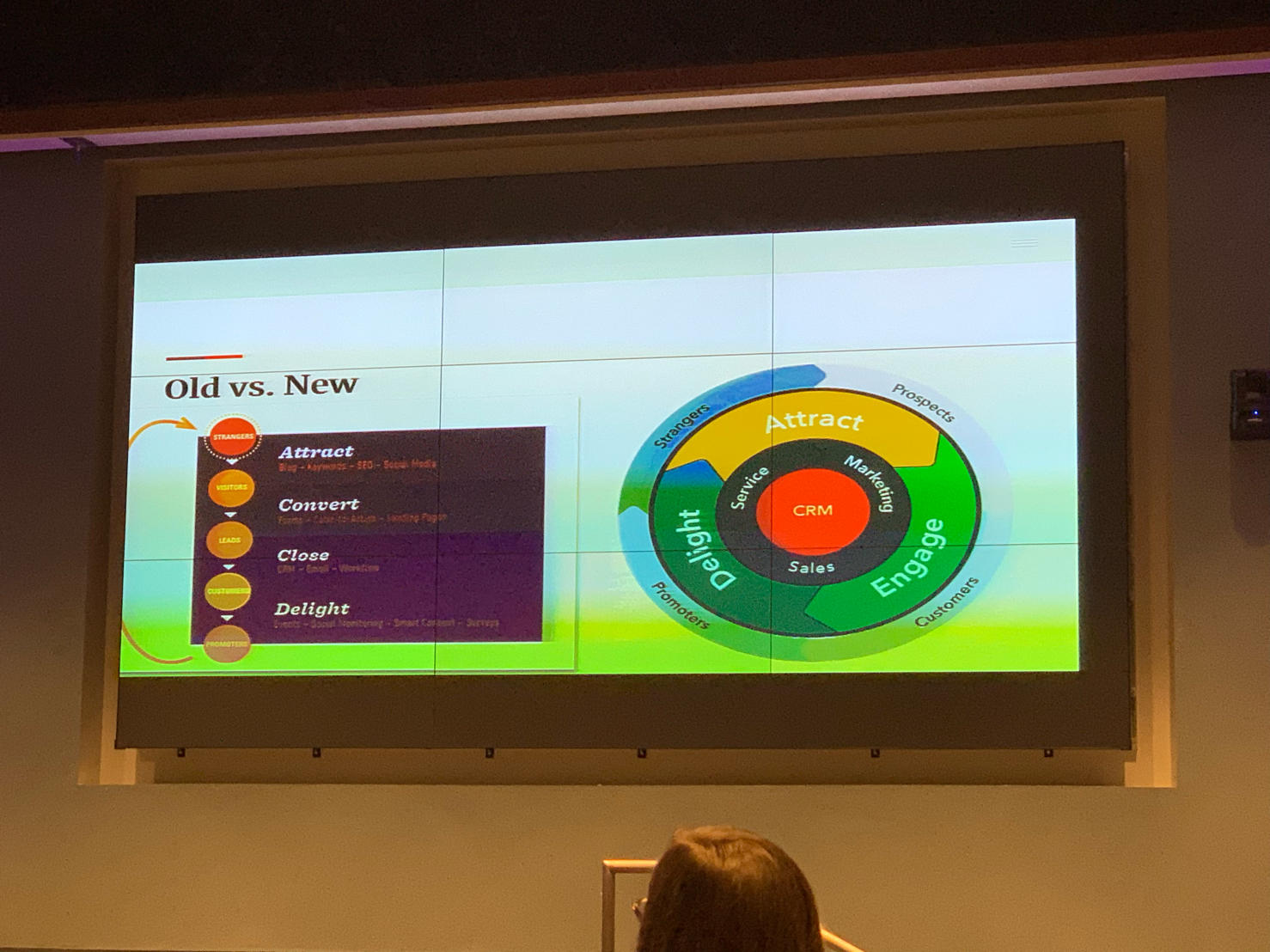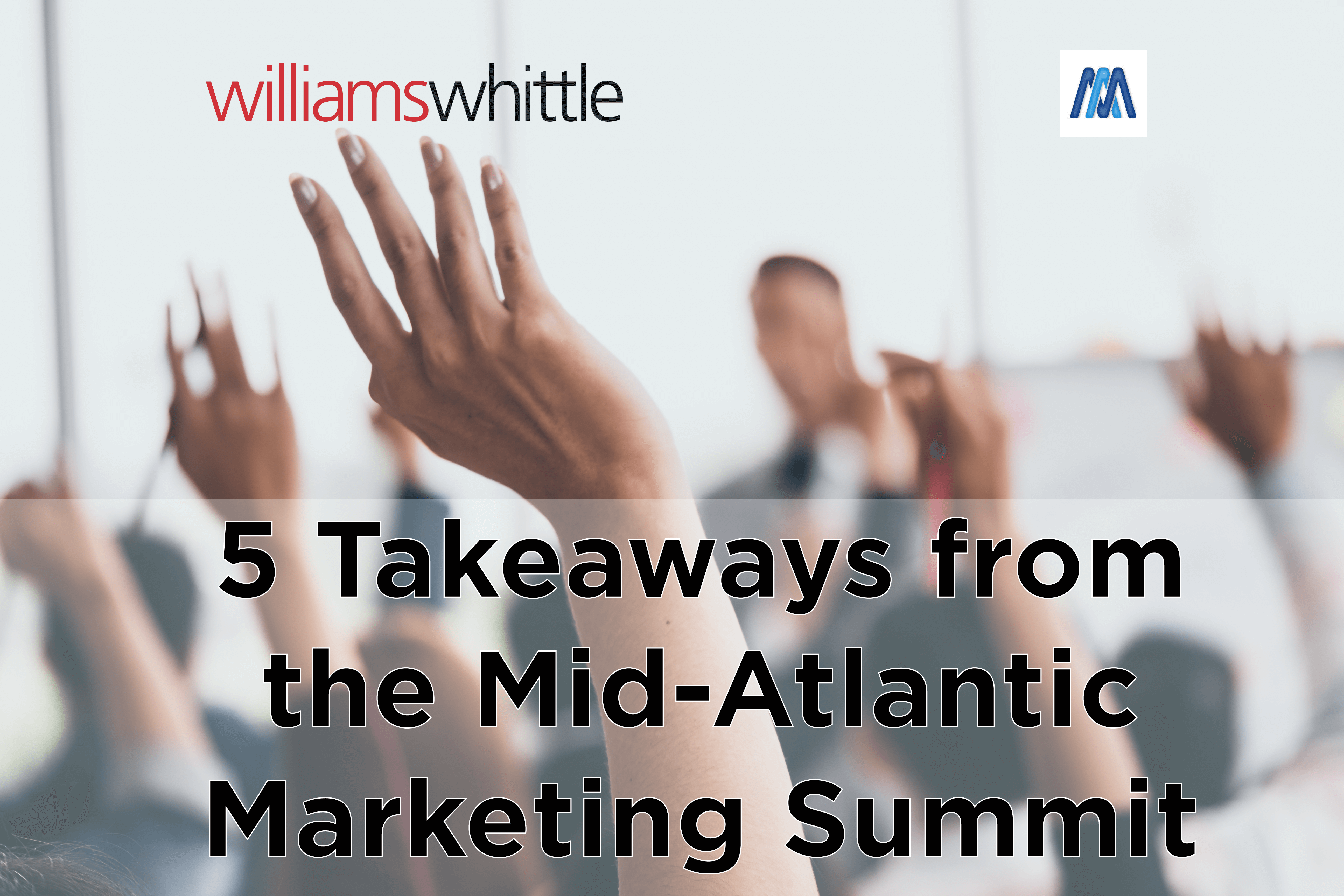Last week, I left the cobblestone streets of Old Town and traveled just a few metro stops away for the Mid-Atlantic Marketing Summit in Washington, DC. Held at the National Education Association, this conference brought together many of the top agencies and brands in the business. I raced from session to session, chatting with old and new colleagues that refreshed my mind on everything from random thoughts on living sustainably to more industry-specific conversations on video production. All the while, I was tweeting insights in real time creating almost a note log for myself to keep track of all the pointers I didn’t want to forget. Now back in Old Town, I reviewed the tweets, typed and handwritten notes I had on the conference to put together my top takeaways from some of the presentations I sat in on to share with you.
Always look for the positive in your competitors.
Matt Smith of SmithGifford gave a feel-good presentation on the exceptional work done in the DC area that reminded me why I am passionate about working here myself. It is easy to get intimidated by the prospect of competition even when it isn’t necessary. Smith encouraged other marketers to stray away from honing in on the negative of their competitor’s work which is only natural to do when you feel inferior. Instead, take the approach of focusing on the positive because it is good for everyone and ultimately creates a productive response of learning and improving. Matt Smith even takes his passion for praising work that isn’t from his agency a step further by penning a weekly column on the Capitol Communicator called ‘Oh That’s Good’ where our work with the Interfaith Council of Metropolitan Washington was featured.
The marketing funnel is changing into a flywheel with a focus on the ‘delight’ phase.
Lynne Kingsley of Ironmark presented insights on inbound marketing that challenged the trusty marketing funnel by instead suggesting it has transformed into a flywheel that continually fuels the movement of the conversion process to continue on its own. The marketing funnel follows the pattern of attraction, conversion, closing and delighting. The consumer moves through this funnel starting as a stranger, then a visitor, a lead, a customer and finally a promoter. In the new flywheel, the person is continually moved by the flywheel through those same personas of the funnel: a stranger, a prospect, then customer and finally a promoter. The promoter can help move others through the same process. The flywheel was explained as a function inside the funnel that follows the pattern attract, engage and delight. The focus on the delight phase echoed the example from Aynat Ravin of Marriott International who spoke of the Surprise and Delight Program they run to sometimes surprise their members with benefits if they are having a bad experience. She spoke of an instance where a member had a terrible travel experience and wrote about it publicly on social media. Marriott reached out to the specific hotel the member was staying at and had treats and champagne delivered to their room to brighten their day. This aspect of the sales funnel or flywheel doesn’t sell anything but creates top of mind brand awareness and free promotion. We can be almost certain that member shared about their surprise delight either on social media or via word of mouth. What kind of promotion could be better than that?

Image Credit: Heather Elliott bit.ly/2GYhtEs
Don’t use social media as a radio blast.
Social media and anything digital is always the most interesting topics to me because of their evolving and ever-changing trends. I sat in on a panel presented by CSWE, Amtrak, REQ, ONE Campaign, and Georgetown University, sharing their insights on how they have been succeeding in the social media world. They challenged my thoughts on what it means to do social media right by reminding me that social media is about community and not just a place to radio blast information on your organization, or a platform that you just post content do and then ignore. Social media is a place to listen and learn from your followers to create content that they are looking for. They suggested to ask your audience questions, survey them and even share their content as a means to provide engagement. My obsessive list making, hyper organized personality who likes to plan ahead and keep everything in little, neat boxes was struck by this perspective. The idea was paralleled by Andrea McCarren of PenFed Credit Union that said: “people don’t need perfect content anymore.” This reminded me that social users just like myself want to engage with other humans. If this means that the content is prepared as it would be for the silver screen that can be ok sometimes if you are engaging with your audience in a way that matters to them and positively impacts your brand.
You have two ‘selves’.
Vidhika Bansal of Carfax enlightened me in her workshop on UX strategies that we have ‘two selves’. One self is the experiencing self and the other is the remembering self. The experiencing self thinks about how it feels in the moment and the remembering self thinks about how it feels overall. As marketers, we are speaking to both selves, but keeping in mind that the remembering self is always in charge. This is why the final aspect of a piece of marketing is so crucial. It must stick in your prospect’s head and stay there. She used the example of the sticker you get when voting. Even if you waited a long time in line to vote you will remember that last impression of your experience when you got a sticker for your effort that you feel proud about what you did. Just a good reminder to make sure and tie together your marketing content so that the overall end result is clear and memorable.
Think about content distribution just as much as content creation.
There were a lot of great conversations on social and digital marketing being that those platforms are at the forefront of the marketing world. In a panel with experts from EnergizeGrowth, Capital One, Podcast Village, PenFed Credit Union, Hilton, and Goodwill Industries International, I got some great insights on content marketing. Instead of getting stuck on the smallest details of a marketing project, we were challenged to redefine ourselves as content producers by Andrea McCarren of PenFed Credit Union, and additionally focus on how the content we create will be distributed. The panel pointed out that consumers of your content are focused on what the content means to them above all else. So instead of trying to make a long-form piece of content appeal to a wide variety of people, repackage it into shorter pieces of content that can reach segmented types of audiences. Then watch your efforts stretch farther than they did before.
Narrowing down a full day of too many presentations and noteworthy speakers to name into just five takeaways is no easy task. If I could add one more takeaway it would be a point on the fascinating world of influencer marketing. While many positive opinions were shared on their ability to reach their trusted audience it seemed that the overall consensus was that they don’t work for every brand and should be treated like any other advertising channel as a means to bring awareness to your message. I couldn’t have asked for a better work week Friday than getting refreshed and rejuvenated with fresh ideas from our peers. Many of the other great takeaways on this event are forever housed on the Twitter thread of #MAMSummit if you are looking for even more insider knowledge from this event. As for me, I look forward to implementing my knowledge with current and future clients.



